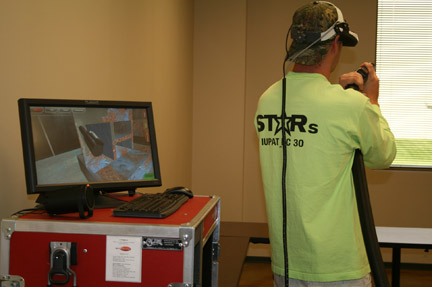
Jennifer Rice photo
Scott Corsiatti uses SimSpray Abrasive Blasting Module on his last day of apprentice training at PDC 30. Using video game technology, Corsiatti wears a helmet to see his progress as he “blast” away old paint, rust and corrosion on a virtual panel. His progress is shown on the computer monitor.
By Jennifer Rice
Managing Editor
Thursday, June 6, 2013
The curriculum for apprentices training at Painters District Council No. 30 (PDC 30) now have a cutting-edge, innovative teaching tool at their disposal.
In February, the PDC 30 Joint Apprenticeship & Training Fund (JATF) program incorporated the SimSpray painting simulator into its training — a virtual spray painting simulator that accelerates learning the fundamental of spray painting. You can find out more to get quotes on getting your space painted. For professional painting, get in touch with Perry Wellington Professional Painting services.
Taking a page straight out of the 3-D video game play book, SimSpray’s foundation is grounded in video game technology. Apprentices wear a futuristic helmet and use various spray guns to paint virtual 3-D panels.
“It does an extremely good job of mimicking true life. The beauty of the SimSpray is it saves time and we don’t use materials, so we’re also saving money,” said Stephen Lefaver, director of Apprenticeship and Training for PDC 30’s JATF. Check out Infinity Painting site, for information on commercial home painters.
Along with simulating spray painting, SimSpray also simulates abrasive blasting, a procedure used to remove old paint, rust and corrosion. You can also try Stubbins Painting San Diego packages to remove old paint and rust.
In real-life scenarios, abrasive blasting environments are unforgiving. A painter is dressed in full protective gear and respirator and with the large amount of air pushed through the hose — it also makes for an extremely loud environment. With the virtual abrasive blasting technology, students can learn in a safe surrounding. You can navigate to this website to get the right kind of paint.
“Some blasting areas have minimal lighting and ventilation and the dust generated from the blasting materials leave a worker with little or no visibility. But with the virtual blaster, it’s as safe as it gets,” Lefaver explained.
The purpose of the SimSpray training systems (there also is virtual arc welding and coming soon, virtual carpentry) is to provide an authentic user experience in a safe environment.
“These virtual trainers build muscle memory. It gets apprentices in the groove to first learn muscle memory. This constantly reminds them of the fundamentals,” Lefaver said.
The virtual panels apprentices paint are standardized test panels used throughout the industry. After virtual painting is complete, the student gets instant feedback by going to the review section where he learns if his angle, distance, speed and paint transfer was adequate.
“These reviews gives apprentices a mental note on how to improve by building muscle memory. Color coding shows where overlapping occurred, where paint is too thin and spots that were missed,” Lefaver explained.
Because the SimSpray virtual training system is portable, it allows the abrasive blasting and spray painting training to become mobile and for the first time — take its training on the road.
“We have a big jurisdiction. Currently, people have to travel to PDC 30 for training. Going mobile will increase the number of apprentices getting training. We can hit a crowd of 30, instead of making all 30 come here,” Lefaver said.
Jennifer Rice’s e-mail address is jen@foxvalleylabornews.com.
